Abstract
Introduction:
The purpose of this study was to evaluate noise levels in dental offices and to estimate the risk and prevalence of tinnitus and noise-induced hearing loss (NIHL) in practicing dentists.
Materials and Methods:
First, measures were collected of sound pressure levels produced by dental handpieces and dental suction in the University of Oklahoma Health Sciences Center (OUHSC) College of Dentistry. Second, a survey was distributed to members of the Oklahoma Dental Association (ODA).
Results:
Measurements made in the dental operatory revealed dangerous levels when high-volume suction was in use alone and in conjunction with a dental handpiece. Questionnaire results suggested that practicing dentists report sensorineural hearing loss at a rate broadly in line with national averages. However, dentists reported a higher prevalence of tinnitus symptoms than would be expected based on sample demographics.
Conclusion:
Results from sound level measurements and questionnaire responses indicate that dentists are a population that could be placing their hearing health at risk in a typical daily work environment.
Keywords: Dentistry, noise-induced hearing loss, tinnitus
Introduction
Dental professionals have been a focus of audiologic research for decades, primarily due to their risk for noise-induced hearing loss (NIHL) and tinnitus due to high levels of noise produced by dental handpieces and suction. However, direct risk assessment studies have found equivocal results. While several studies have measured or estimated noise levels in dental offices that do not exceed Occupational Safety and Health Administration (OSHA) permissible noise levels, others have found the opposite, stating that levels can and do reach dangerous levels.[1,2,3,4,5,6] For example, one study evaluating handpiece noise found that high-speed dental handpieces could produce noise as loud as 87.3 dBA, which exceeds the OSHA action level for an eight-hour time-weighted average.[7] Another study noted sound pressure levels as high as 102 dB SPL produced by one high-speed handpiece.[6] However, newer electrically powered dental equipment may produce lower levels of noise that do not reach the action level.[8] Previous studies have also used different estimates of exposure time for dentists, which may help to explain conflicting findings and recommendations. It is notable that, while modernization of high-speed dental handpieces generally has made them quieter, the literature on this topic does not reflect a trend toward decreased noise exposure risk by dental professionals.[1,2,3,4,5,6]
In addition to assessment of noise risk, a few studies have evaluated hearing thresholds among dental professionals and attempted to relate these to noise exposure. Most notably, Messano and Petti[9] compared hearing thresholds of physicians to their dental professional peers. They found that the physicians had better hearing thresholds than the dentists. This study supported similar findings by Zubick and colleagues two decades previously.[10] Additionally, a study investigating hearing loss in students found that dental students experienced a temporary threshold shift (TTS) after using dental handpieces in their dental laboratories.[11] The authors of this study noted that repeated TTS can lead to a permanent threshold shift, though whether this had occurred in the study sample was not assessed directly. Similarly, Theodoroff and Folmer[6] described significantly poorer hearing thresholds among dental professionals using high-speed handpieces compared to dental professionals and dental students who did not use those handpieces, suggesting that use of potentially noisy dental equipment may contribute to hearing loss among dentists.
Tinnitus in dentists has not been largely explored, but there have been two recent surveys reporting prevalence statistics. A survey of South African dentists found that 31.85% experienced tinnitus.[12] Another survey of dental professionals in the United Arab Emirates found that 21% of the professionals surveyed reported hearing related problems after working in the dental office, while 37% reported tinnitus.[13] No published reports of tinnitus prevalence among dentists in the United States could be identified.
There remains a need to assess potential risk of NIHL and tinnitus among dental professionals using modern equipment, to compare among dental handpieces, and to calculate noise exposure risk based on exposure time. The present study addresses these questions using a combination of direct measurement of noise levels produced by several modern dental handpieces and a survey assessment of noise exposure, hearing loss, and tinnitus self-report by dentists in practice.
Materials and Methods
Sound level measurement – individual handpieces
To estimate noise levels in dental offices, sound level measurements were made of multiple handpieces used by a licensed dental professional in a practice operatory of the University of Oklahoma Health Sciences Center College of Dentistry [Figure 1]. A dental simulation mannequin was used to measure the noise each handpiece produced while operating on the tooth (here, a synthetic tooth enamel used in dental training). Measurements were made in eight handpieces and/or suction conditions [Figure 2]. All handpieces were powered using the same turbine system and a medium burr. For each handpiece, a measurement was taken with the handpiece running approximately 12–18 in. from the mannequin mouth. A high-volume dental suction system with a thumb-operated air valve was also assessed with the valve unobstructed, obstructed, and unobstructed in combination with a running handpiece. These measurements provided a representation of several devices in common use in dental clinics as well as the commonly used combination of simultaneous drilling and suction. Measurements were conducted using an Ivie IE-45 real-time sound analyzer with a ½-inch microphone. All measurements are reported in dBA with slow response time weighting. For each device condition, sound levels were averaged over a 20-second time window.
Figure 1.
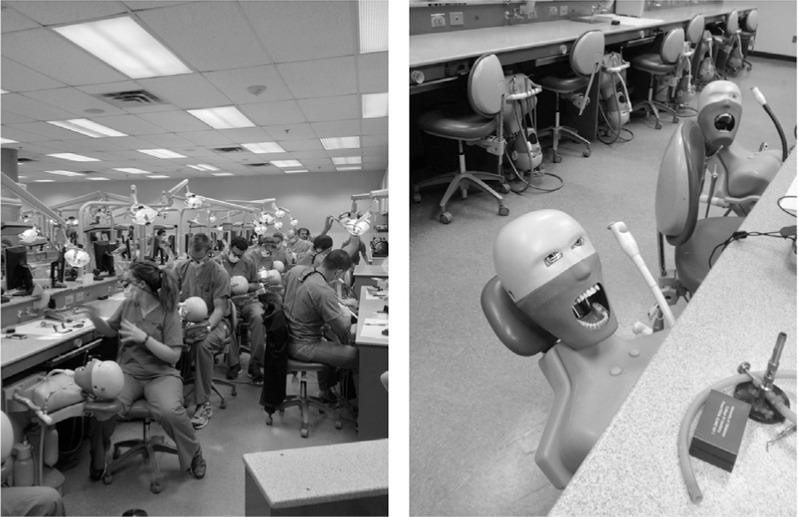
Dental training operatory and simulation mannequins used for noise measurement
Figure 2.

Average A-weighted sound pressure level for five dental handpieces and suction
Sound level measurement – training operatory
Sound level measurements also were made during a dental student simulation laboratory exam. During the exam, up to 60 high-speed dental handpieces were running simultaneously within a single enclosed operatory, simulating a busy high-capacity dental practice. Using the instrumentation described above, A-weighted sound level measurements were made at 12 locations in the operatory, including four at the ear level of a handpiece operator while he/she used the handpiece [Figure 3].
Figure 3.
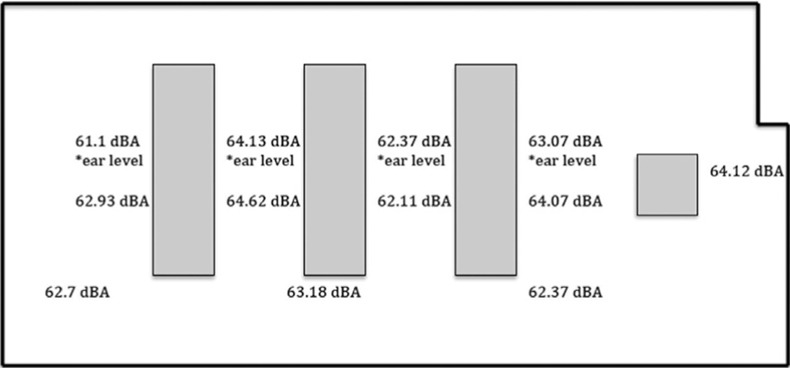
Diagram of dental training operatory with A-weighted sound pressure measurements
Survey of Oklahoma dentists
A short questionnaire was mailed to all members of the Oklahoma Dental Association (ODA) with valid mailing addresses. This questionnaire [Appendix 1] was designed to (1) evaluate the range of noise exposures of dental professionals and (2) estimate the prevalence of NIHL and tinnitus in this population. Respondents were asked to return the completed survey using an enclosed postage-paid envelope. The first portion of the survey requested respondents’ demographic information including gender, age, and years in dental practice. The second portion asked whether the respondent had been diagnosed with a hearing loss or experienced tinnitus. Respondents who reported experiencing tinnitus completed additional questions assessing the frequency, severity, and nature of that tinnitus. Finally, a third section probed potential noise exposures in the dental setting (how noisy the office was perceived to be, how often dental handpieces were in use, whether hearing protection was used) and outside of work (quiet and noisy recreational activities).
Results
Sound level measurement – individual handpieces
Average noise levels produced in each of the dental handpiece combinations were displayed in Table 1. When used in isolation, sound pressure levels produced by the dental handpieces examined ranged from 70.4 to 83.6 dBA. No dental handpiece produced noise in excess of the National Institute for Occupational Safety and Health (NIOSH) eight-hour time-weighted average permissible exposure limit of 85 dBA.[14] However, two conditions (obstructed suction [96.5 dBA] and unobstructed suction with an operating dental handpiece [94.8 dBA]), exceeded 85 dBA, suggesting the potential for harmful exposure.
Table 1.
A-weighted sound pressure level for dental handpieces and suction with NIOSH-estimated exposure limit for each level
| Instrument | Average sound pressure (dBA) | NIOSH permissible exposure time (h)[13] |
|---|---|---|
| 430 handpiece | 83.59 | 8 |
| Midwest handpiece | 80.43 | 8 |
| 430k handpiece | 83.47 | 8 |
| Solara handpiece | 71.58 | 8 |
| Low-speed handpiece | 70.41 | 8 |
| Suction obstructed | 96.47 | 1 |
| Suction unobstructed | 79.29 | 8 |
| Suction and handpiece | 94.77 | 1 |
Sound level measurement − training operatory
As indicated in Figure 3, noise levels measured in a dental training operatory with many dental handpieces running simultaneously did not approach NIOSH permissible exposure limits. Of note, training clinicians did not utilize suction during these measurements as they were training using dental mannequins.
Survey of Oklahoma dentists
Questionnaires were mailed to 395 members of ODA with valid mailing addresses. Of these, 144 surveys were completed and returned, yielding a 36.5% response rate. Analyses were conducted based on these 144 responses.
Demographics
The mean age of respondents to the questionnaire was 57.5 (SD = 9.8) years old, with the maximum age being 76 and youngest respondent being 35 years of age. The mean number of years in practice was 27.2 years (SD = 10.1). A majority (83.3%) of respondents were male, which is consistent with the gender distribution of US dental professionals (reported as approximately 77.8% male in a 2009 survey of the American Dental Association, with increasing female participation in the profession in recent years).
Self-report of hearing loss
Approximately one in four respondents reported having been diagnosed with hearing loss, with over half of those respondents being 60 years of age or older. Prevalence of hearing loss diagnosis was compared to national estimates from the National Health and Nutritional Examination Surveys of unilateral or bilateral hearing loss by age decade.[15] For all age groups participating in the survey, hearing loss prevalence was similar to or slightly lower than national averages [Table 2].
Table 2.
Comparison of hearing loss prevalence in survey sample to US estimates (National Health and Nutritional Examination Surveys[14])
| Age range | % of Oklahoma dentists reporting hearing loss | NHANES estimated hearing loss prevalence[14] |
|---|---|---|
| 30–39 | 0% (n = 18) | 5.4% |
| 40–49 | 13.6% (n = 22) | 12.9% |
| 50–59 | 22.0% (n = 50) | 28.5% |
| 60–69 | 40.8% (n = 49) | 44.9% |
| 70–79 | 40.0% (n = 5) | 68.1% |
When asked whether they believed their work as a dentist had caused a change in their hearing, 31.3% of respondents reported that they believed it had, while 37.5% were not sure.
Self-report of tinnitus
Nearly one in three respondents reported experiencing some tinnitus. Of those reporting tinnitus, one in three rated the severity of that tinnitus as either “highly bothersome” (2%) or “somewhat bothersome” (31%) [Figure 4]. Nearly two in three respondents reporting tinnitus (64%) described it as “constant” [Figure 5]. In every age group participating in the survey, tinnitus prevalence exceeded national averages estimated by Kochkin and colleagues in the 2011 MarkeTrak VIII survey [Table 3].[16]
Figure 4.
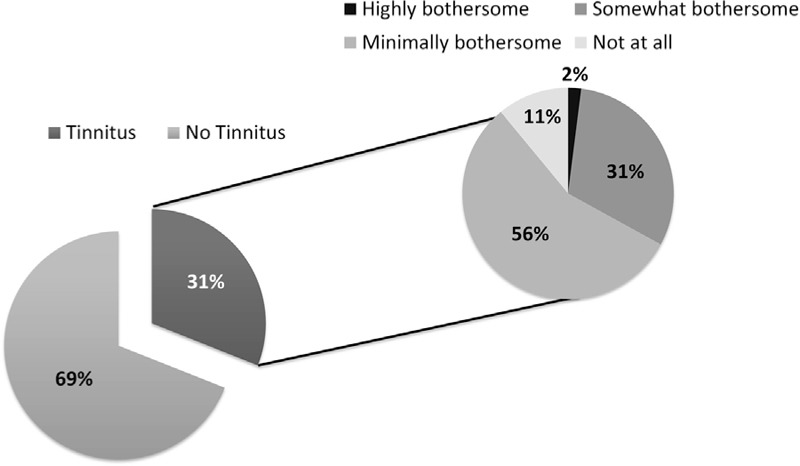
Percentage of respondents reporting tinnitus and self-rating of tinnitus severity
Figure 5.
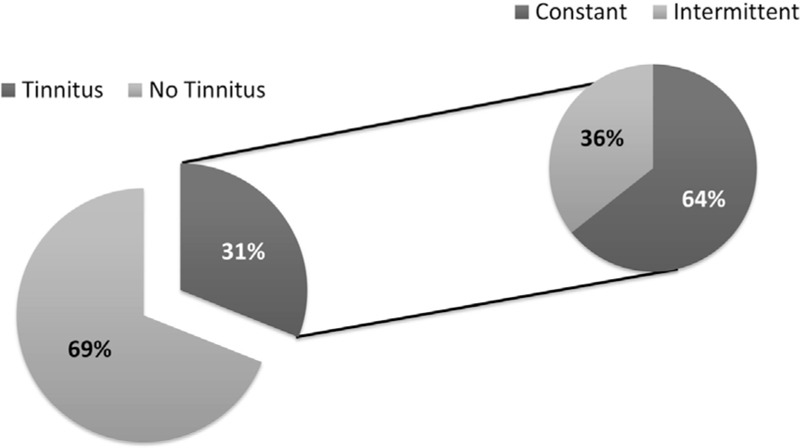
Percentage of respondents reporting tinnitus and self-rating of tinnitus as constant or intermittent
Table 3.
Comparison of tinnitus prevalence in survey sample to US estimates (Marketrak VIII[15])
| Age range | % of Oklahoma dentists reporting tinnitus | MarkeTrak VIII estimated tinnitus prevalence[15] |
|---|---|---|
| 35–44 | 13.8% (n = 29) | 8.6% |
| 45–54 | 37.0% (n = 27) | 13.9% |
| 55–64 | 34.3% (n = 70) | 20.6% |
| 65–74 | 37.5% (n = 16) | 26.7% |
| 75–84 | 50.0% (n = 2) | 26.7% |
When asked whether they perceived their tinnitus to be worse at the end of their workday, 17.8% of respondents with tinnitus answered positively. Over one quarter (26.7%) of those experiencing tinnitus reported that they believed their tinnitus to be a result of working in a dental practice, while 53.3% were not sure if their work as a dentist contributed their tinnitus.
Non-occupational noise exposure
While non-occupational behaviors placing respondents at risk for NIHL and tinnitus could not be assessed directly, respondents were asked to select leisure activities in which they participated. These included both high-noise-risk (e.g., hunting, motorcycle riding, firearm shooting) and low-noise-risk (e.g., reading, gardening, swimming) activities. Respondents reported participating in an average of 2.2 noisy activities (SD = 1.5, median = 2).
The number of noisy activities in which a respondent reported participating did not significantly predict hearing loss status or tinnitus status. Individuals who reported hearing loss participated in an average of 2.4 noisy activities (SD = 1.7) compared to 2.1 activities (SD = 1.5) for individuals who did not report hearing loss, which was not a significant difference (t[138] = 1.01, P = 0.31). Individuals who reported tinnitus participated in an average of 2.3 noisy activities (SD = 1.7) compared to 2.2 activities (SD = 1.5) for individuals who did not report hearing loss, which was not a significant difference (t[142] = 0.12, P = 0.90).
Occupational noise exposure
To estimate each respondent's exposure to noise produced by dental handpieces and suction per day, reported weekly exposure was divided by five to estimate daily exposure [see Figure 6 for distribution]. On the basis of these estimates, 94% of respondents used suction either alone or in combination with a dental handpiece at least 1 h per day. Recall that sound level measurements reported previously indicated that obstructed suction and suction in concert with a dental handpiece may produce sound pressure levels in excess of 94 dBA. Using the NIOSH-recommended permissible exposure limit of 85 dBA, time-weighted to 8 h, exposure to noise at 94 dBA should be limited to 1 h a day or less.[14] A related finding was the very low rate of use of hearing protection devices (HPDs); 96% of the dentists surveyed replied that they do not use HPDs, only one dentist replied using HPDs routinely while in practice. This finding is consistent with previous surveys of HPD use among dental professionals.[6]
Figure 6.
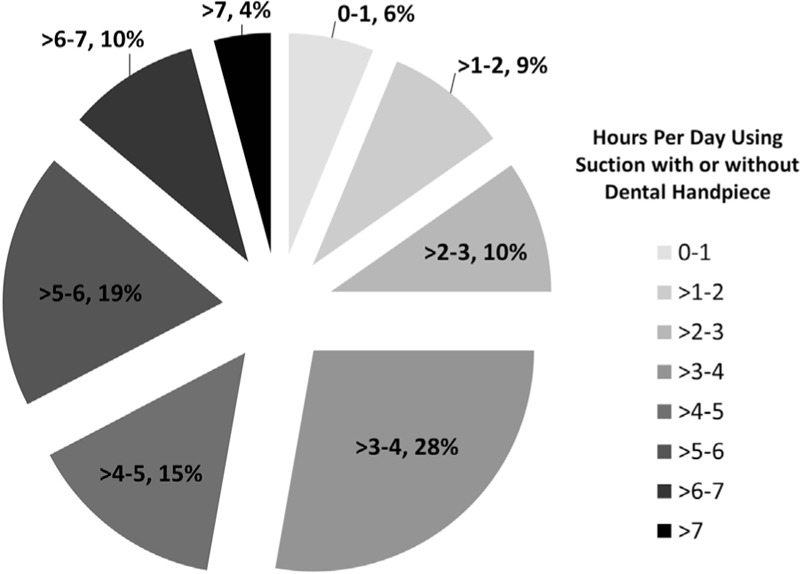
Self-reported average use of suction with or without dental handpiece in hours per day
Self-reported hearing loss was related to self-reported exposure to workplace noise. This was estimated by computing hours per day spent using dental handpieces, suction, or both (described above), as well as by self-rating of the office noise environment. Respondents who reported hearing loss were exposed to handpiece and suction noise for an average of 4.5 h per day (SD = 1.7) compared to 3.7 h per day (SD = 2.1) for individuals who did not report hearing loss, which was a significant difference (t[138] = 2.20, P = 0.03). Respondents reporting hearing loss also rated their work environment as significantly louder than respondents without hearing loss (U = 1249.00, P = 0.02).
Self-reported tinnitus was not predicted by hours spent using dental handpieces or suction, but was related to rating of the workplace noise environment. Individuals who reported tinnitus were exposed to handpiece and suction noise for an average of 4.3 h per day (SD = 1.7) compared to 4.2 h per day (SD = 2.0) for individuals who did not report tinnitus, which was not a significant difference (t[142] = 0.38, P = 0.70). However, respondents reporting tinnitus rated their work environment as significantly louder than respondents without tinnitus (U = 1500.50, P = 0.009).
Discussion
Sound level measurements and survey responses reported here raise some concerns for dentists’ hearing health. While most dental handpieces evaluated did not produce noise that reaches dangerous levels, use of suction with and without accompanying handpiece use can produce noise sufficient to damage the user's hearing. Based on survey responses, dentists may use suction and handpieces for enough time per day to exceed NIOSH-recommended permissible exposure limits. Where possible, dental professionals should limit exposure to these noise sources and/or make use of hearing protective devices to reduce noise risk. In particular, semi-insert earplugs may allow dental professionals to quickly insert and remove hearing protection without disrupting patient care.
On the basis of self-report, dental professionals responding to the survey reported here exhibit hearing loss at a rate similar to national averages, but a considerably higher rate of tinnitus. Tinnitus is known to be associated with noise-induced sensorineural hearing loss and may herald a change in hearing that has not yet been detected by the individual or not yet diagnosed by a hearing healthcare professional. Recall that hearing loss estimates in the present study were based on self-report of hearing loss diagnosis and so may underestimate the true rate of hearing loss in the survey sample.
Two other studies of dental professionals in the United Arab Emirates (UAE) and South Africa have also found a high rate of tinnitus among dental professionals. Elmehdi[13] reported that 37% of dental professionals in the UAE reported tinnitus, which is similar to our finding of 31.3% of surveyed dentists reporting tinnitus. Elmehdi also conducted sound level measurements of high-speed handpieces and found that the sound levels neared maximum permissible limits, but did not exceed them, which is broadly in line with the present study's findings.[13] Similarly, Sidley[12] found that 31.9% of dentists surveyed in South Africa reported experiencing tinnitus, and 36.49% reported hearing loss.
When evaluating potential risk factors for hearing loss and tinnitus, as reported on the survey, participation in noisy recreational activities was not predictive of hearing loss or tinnitus status. However, respondents reporting that they had been diagnosed with hearing loss reported significantly more exposure time to noise from dental handpieces and suction. In addition, individuals reporting hearing loss and those reporting tinnitus were both significantly more likely to rate their daily work environment as noisy compared to individuals who denied hearing loss diagnosis or tinnitus. These findings suggest that hearing loss and tinnitus reported by dentists participating in the study may be related to workplace noise exposure from dental handpieces and suction. Direct measurement of hearing status and workplace noise would elucidate this relation more clearly. Few studies have evaluated the prevalence of hearing loss among dentists; however, Messano and Petti[9] found that dentists had a higher prevalence of hearing loss (30.0%) compared to their general practitioner peers (14.8%). That study reveals a larger prevalence than the current study found. Other similar studies compared hearing thresholds of dentists to other professional peers, and found that dentists had higher hearing thresholds than other health professionals.[10] In addition, dental professionals with a history of high-speed handpiece use appear to have poorer hearing thresholds than other dental professionals who do not use those devices.[6]
Furthermore, the present study only assessed noise within the audible spectrum (below 20,000 Hz) using conventional sound level measurement equipment. Many dental handpieces pulse or rotate at a faster rate than 20,000 cycles per second, and therefore produce noise in the ultrasonic spectrum. Measurement of this noise, which requires special instrumentation, may reveal an increased risk of noise exposure. Sorainen and Rytkönen[2] reported that one ultrasonic scaler produced a sound pressure level of 107 dB SPL at 25,000 Hz. Research has shown that ultrasonic sounds (above 20,000 Hz) are inaudible to listeners; the individual is typically hearing the subharmonics of the ultrasonic sound source. Ultrasonic frequency sounds dissipate easily, and are therefore a low risk hazard for hearing health.[17]
Conclusions
Results from the present study suggest that dentists are at risk of exposure to hazardous noise levels in their work environment, with that risk related to time of exposure to dental handpieces and suction. Although the rate of hearing loss diagnosis in the survey sample was no greater than US population estimates in any age group assessed, the rate of tinnitus appeared to be much higher. In addition, both diagnosis of hearing loss and report of tinnitus were positively related to perception of a noisy work environment (though not to noisy leisure activities). Hearing loss and tinnitus risk may be abated by use of HPDs. The current survey suggests that this is a needed area of intervention and education for dental professionals, as only one respondent reported regular HPD use. Further research that directly assesses change in hearing thresholds and tinnitus associated with dental handpiece and suction use, as well as direct measurement of ultrasonic noise, is indicated.
Financial support and sponsorship
Funding for the present study was provided, in part, by an OUHSC College of Allied Health Student Research and Creativity Award to the first author.
Conflicts of interest
There are no conflicts of interest.
Acknowledgements
The authors acknowledge the faculty and students of the University of Oklahoma Health Sciences Center (OUHSC) College of Dentistry for providing access to training operatories as well as the members of ODA for their participation in the survey.
APPENDIX 1: Survey Mailed To Members Of The Oklahoma Dental Association

Thank you for your time in completing this survey, please answer the following
Gender: Male Female
_____ What is your age?
_____ How long have you been practicing dentistry?
Have you been diagnosed with a hearing loss? ◻ Yes ◻ No ◻ I’m Not Sure
If you answered yes to the previous question:
When were you diagnosed? ____________________________
How much hearing loss do you have? ____________________________
Who gave you the diagnosis? ____________________________
Do you wear a hearin gaid? ◻ Yes ◻ No ◻ Not anymore
Do you experience tinnitus (ringing buzzing, or noises in the ears)? ◻ Yes ◻ No
If you answered yes to theprevious question:
How would you describe your tinnitus?
______________________________________
Is your tinnitus constant or intermittent?
◻ Constant ◻ Intermittent
How bothersome is your tinnitus?
◻ Highly ◻ Somewhat ◻ Minimally ◻ Not at all
Is your tinnitus worse at the end of your workday?
◻ Yes ◻ No ◻ I’m not sure

During the workday, would you describe your office as:
◻ Very noisy ◻ Somewhat noisy ◻ Somewhat quiet ◻ Veiy quiet
Do you wear hearing protection in your office?
◻ Yes ◻ No ◻ Sometimes
_____ Approximately how many hours a week do you spend using a suction? (With or without the use of another tool)
_____Approximately how many hours a week do you spend using a dental handpiece?
Approximately how many hours per week do you use each handpiece?
_____High speed dental handpiece
_____Low speed dental handpiece
_____Electric handpiece
Do you feel that your work as a dentist has caused a change in your hearing?
◻ Yes ◻ No ◻ I’m not sure
Do you feel that your work as a dentist has caused a change in your tinnitus?
◻ Yes ◻ No ◻ I’m not sure ◻ N/A
Check all activities or hobbies you participate in:
◻Reading ◻Riding All-Terrain Vehicles
◻Running ◻Golf
◻Walking ◻Swimming
◻Hiking ◻Motorcycle Riding
◻Boating ◻Attending Concerts
◻Hunting ◻Firearm Shooting
◻Fishing ◻Attending Movies
◻Bicycling ◻Attending College or Professional
◻Camping ◻Sporting Events
◻Gardening ◻Other/Unlisted (please list all)
◻Woodworking ______________________
Thank you for participating in this survey!

References
- 1.Setcos JC, Mahyuddin A. Noise levels encountered in dental clinical and laboratory practice. Int J Prosthodont. 1998;11:150–7. [PubMed] [Google Scholar]
- 2.Sorainen E, Rytkönen E. Noise level and ultrasound spectra during burring. Clin Oral Investig. 2002;6:133–6. doi: 10.1007/s00784-002-0163-6. [DOI] [PubMed] [Google Scholar]
- 3.Brusis T, Hilger R, Niggeloh R, Huedepohl J, Thiesen KW. Are professional dental health care workers (dentists, dental technicians, assistants) in danger of noise induced hearing loss? Laryngorhinootologie. 2008;87:335–40. doi: 10.1055/s-2007-995328. [DOI] [PubMed] [Google Scholar]
- 4.Jadid K, Klein U, Meinke D. Assessment of noise exposures in a pediatric dentistry residency clinic. Pediatr Dent. 2011;33:343–8. [PubMed] [Google Scholar]
- 5.Sampaio Fernandes JC, Carvalho AP, Gallas M, Vaz P, Matos PA. Noise levels in dental schools. Eur J Dent Educ. 2006;10:32–7. doi: 10.1111/j.1600-0579.2006.00393.x. [DOI] [PubMed] [Google Scholar]
- 6.Theodoroff SM, Folmer RL. Hearing loss associated with long-term exposure to high-speed dental handpieces. Gen Dent. 2015;63:71–6. [PubMed] [Google Scholar]
- 7.Mueller HJ, Sabri ZI, Suchak AJ, McGill S, Standford JW. Noise level evaluation of dental handpieces. J Oral Rehabil. 1986;13:279–92. doi: 10.1111/j.1365-2842.1986.tb00660.x. [DOI] [PubMed] [Google Scholar]
- 8.Dutta A, Mala K, Acharya SR. Sound levels in conservative dentistry and endodontics clinic. J Conserv Dent. 2013;16:121–5. doi: 10.4103/0972-0707.108188. [DOI] [PMC free article] [PubMed] [Google Scholar]
- 9.Messano GA, Petti S. General dental practitioners and hearing impairment. J Dent. 2012;40:821–8. doi: 10.1016/j.jdent.2012.06.006. [DOI] [PubMed] [Google Scholar]
- 10.Zubick HH, Tolentino AT, Boffa J. Hearing loss and the high speed dental handpiece. Am J Public Health. 1980;70:633–5. doi: 10.2105/ajph.70.6.633. [DOI] [PMC free article] [PubMed] [Google Scholar]
- 11.Bowman DC, Blanchet LJ, Doemling DB. Temporary auditory threshold shift from following sophomore operative technique laboratory. J Dent Educ. 1980;44:261–3. [PubMed] [Google Scholar]
- 12.Sidley CG. Prevalence of tinnitus and hearing loss in south African dentists and an investigation into possible connections with noise levels and frequencies in the dental environment [unpublished thesis] Stellenbosch, South Africa: University of Stellenbosch; 2004. [Google Scholar]
- 13.Elmehdi HM. Noise levels in UAE dental clinics: Health impact on dental healthcare professionals. J Public Health Front. 2013;2:189–92. [Google Scholar]
- 14.US Department of Health and Human Services. Occupational noise exposure: Revised criteria 1998 (DHHS [NIOSH] Publication No.98-126) Cincinnati (OH): National Institute for Occupational Safety and Health; 1998. [Google Scholar]
- 15.Lin FR, Niparko JK, Ferrucci L. Hearing loss prevalence in the United States. Arch Intern Med. 2011;171:1851–2. doi: 10.1001/archinternmed.2011.506. [DOI] [PMC free article] [PubMed] [Google Scholar]
- 16.Kochkin S, Tyler R, Born J. MarkeTrak VIII: The prevalence of tinnitus in the United States and the self-reported efficacy of various treatments. Hear Rev. 2011;18:10–27. [Google Scholar]
- 17.Occupational Safety and Health Administration. Occupational safety and health regulations (29 CFR 1910.95 [subpart G]; 48 Fed. Reg., 9776-9785) Washington (DC): Occupational Safety and Health Administration; 1983. [Google Scholar]


